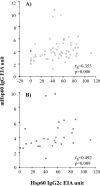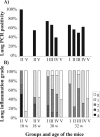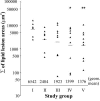Effects of repeated Chlamydia pneumoniae inoculations on aortic lipid accumulation and inflammatory response in C57BL/6J mice
- PMID: 16177317
- PMCID: PMC1230915
- DOI: 10.1128/IAI.73.10.6458-6466.2005
Effects of repeated Chlamydia pneumoniae inoculations on aortic lipid accumulation and inflammatory response in C57BL/6J mice
Abstract
Chlamydia pneumoniae is a common respiratory tract pathogen, and persistent infections have been associated with atherosclerosis. We studied the effects of repeated chlamydial inoculations on the inflammatory response and on aortic lipid accumulation in C57BL/6J mice. Mice fed a diet supplemented with 0.2% cholesterol were infected three or six times with C. pneumoniae every fourth week. Sera and lungs were analyzed for inflammatory responses, lung tissues were tested for the presence of C. pneumoniae DNA and RNA, and intimal lipid accumulation in the aortic sinus was quantified. High levels of chlamydial heat shock protein 60 (Hsp60) immunoglobulin G2c subclass antibodies were detected in all of the infected mice, and a positive and statistically significant correlation was found between these antibodies and autoantibodies against mouse Hsp60. Both Hsp60 antibody levels correlated with the severity of lung tissue inflammation. The cholesterol supplement in the diet had no effect on serum cholesterol levels. Significantly larger intimal lipid lesions were seen in the mouse group infected six times (6,542 mum(2)) than in the control group (1,376 mum(2); P = 0.034). In conclusion, repeated inoculations increased aortic sinus lipid accumulation in normocholesterolemic mice. The correlation between the antibodies to mouse and chlamydial Hsp60 proteins and their association with lung inflammation further support the theory of the development of an autoimmune response against heat shock proteins after repeated chlamydial infections.
Figures




Similar articles
-
Heat shock protein 60 autoimmunity and early lipid lesions in cholesterol-fed C57BL/6JBom mice during Chlamydia pneumoniae infection.Atherosclerosis. 2004 Dec;177(2):321-8. doi: 10.1016/j.atherosclerosis.2004.08.021. Atherosclerosis. 2004. PMID: 15530906
-
Chlamydia pneumoniae infections augment atherosclerotic lesion formation: a role for serum amyloid P.APMIS. 2006 Feb;114(2):117-26. doi: 10.1111/j.1600-0463.2006.apm_205.x. APMIS. 2006. PMID: 16519748
-
Effect of azithromycin on murine arteriosclerosis exacerbated by Chlamydia pneumoniae.J Infect Dis. 2001 Jan 15;183(2):232-238. doi: 10.1086/317941. Epub 2000 Dec 13. J Infect Dis. 2001. PMID: 11120929
-
Mouse models of C. pneumoniae infection and atherosclerosis.J Infect Dis. 2000 Jun;181 Suppl 3:S508-13. doi: 10.1086/315629. J Infect Dis. 2000. PMID: 10839749 Review.
-
Chlamydia pneumoniae and atherosclerosis.Semin Respir Infect. 2003 Mar;18(1):48-54. doi: 10.1053/srin.2003.50006. Semin Respir Infect. 2003. PMID: 12652454 Review.
Cited by
-
Genome-wide analysis of Chlamydophila pneumoniae gene expression at the late stage of infection.DNA Res. 2008 Apr 30;15(2):83-91. doi: 10.1093/dnares/dsm032. Epub 2008 Jan 24. DNA Res. 2008. PMID: 18222926 Free PMC article.
-
TLR/MyD88 and liver X receptor alpha signaling pathways reciprocally control Chlamydia pneumoniae-induced acceleration of atherosclerosis.J Immunol. 2008 Nov 15;181(10):7176-85. doi: 10.4049/jimmunol.181.10.7176. J Immunol. 2008. PMID: 18981139 Free PMC article.
-
Chlamydia pneumoniae Infection and Inflammatory Diseases.For Immunopathol Dis Therap. 2016;7(3-4):237-254. doi: 10.1615/ForumImmunDisTher.2017020161. For Immunopathol Dis Therap. 2016. PMID: 30687565 Free PMC article.
-
A single infection with Chlamydia pneumoniae is sufficient to exacerbate atherosclerosis in ApoE deficient mice.Cell Immunol. 2015 Mar;294(1):25-32. doi: 10.1016/j.cellimm.2015.01.007. Epub 2015 Jan 30. Cell Immunol. 2015. PMID: 25666507 Free PMC article.
-
Chlamydial and periodontal pathogens induce hepatic inflammation and fatty acid imbalance in apolipoprotein E-deficient mice.Infect Immun. 2009 Aug;77(8):3442-9. doi: 10.1128/IAI.00389-09. Epub 2009 May 18. Infect Immun. 2009. PMID: 19451238 Free PMC article.
References
-
- Belland, R. J., S. P. Ouellette, J. Gieffers, and G. I. Byrne. 2004. Chlamydia pneumoniae and atherosclerosis. Cell Microbiol. 6:117-127. - PubMed
Publication types
MeSH terms
Substances
LinkOut - more resources
Full Text Sources
Research Materials
Miscellaneous

